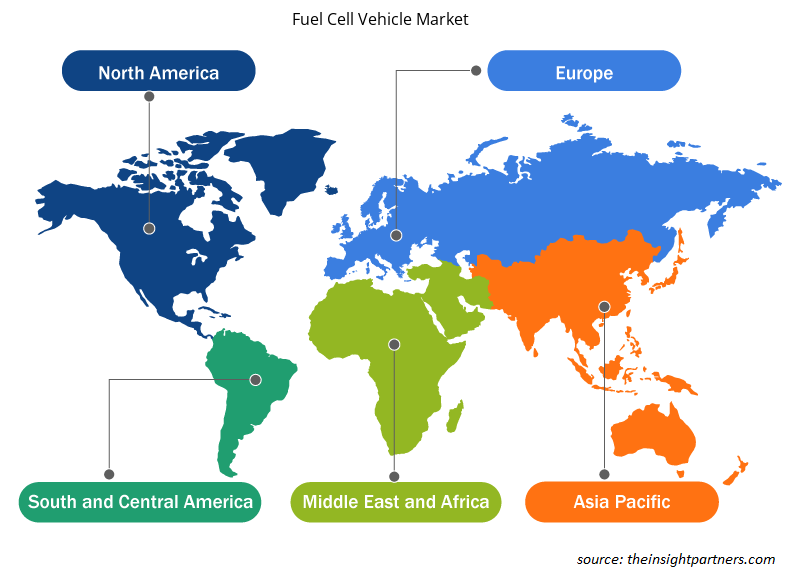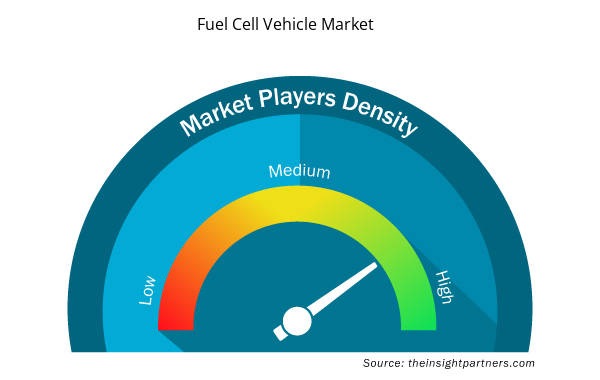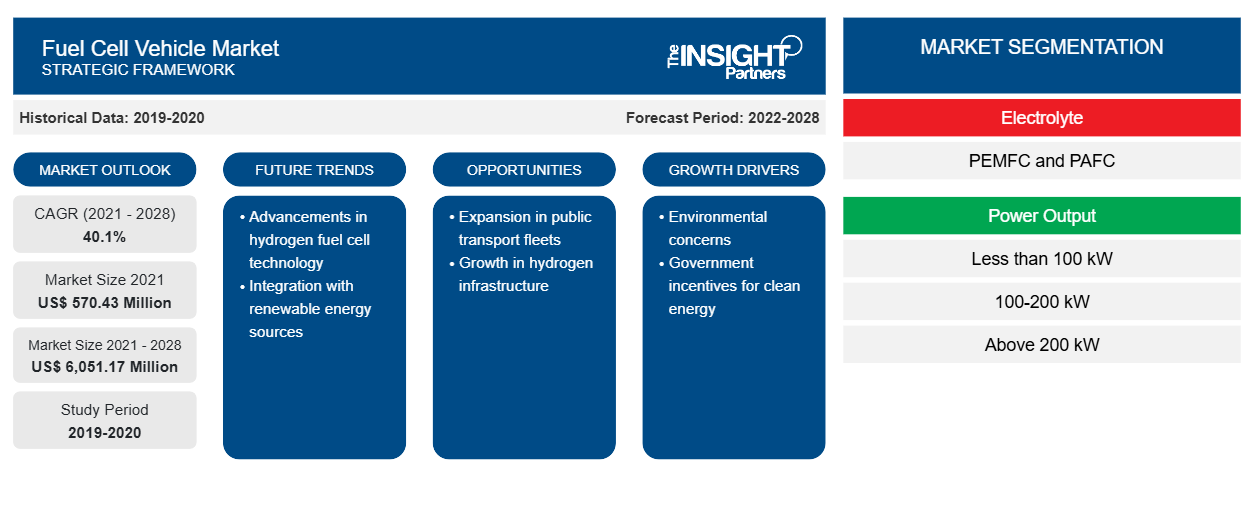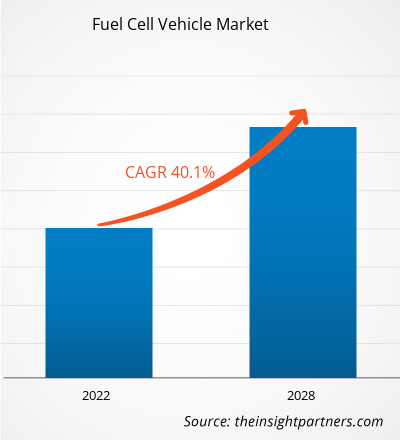[تقرير بحثي] من المتوقع أن يصل سوق مركبات خلايا الوقود إلى 6،051.17 مليون دولار أمريكي بحلول عام 2028 من 570.43 مليون دولار أمريكي في عام 2021؛ ومن المتوقع أن يسجل معدل نمو سنوي مركب بنسبة 40.1٪ خلال الفترة 2021-2028.
وجهة نظر المحلل:
في السنوات الأخيرة، اكتسب سوق مركبات خلايا الوقود اهتمامًا وزخمًا كبيرين كبديل واعد للسيارات التقليدية التي تعمل بالبنزين. تعمل مركبات خلايا الوقود (FCVs) بخلايا وقود الهيدروجين، والتي تحفز الكهرباء من خلال تفاعل كيميائي بين الهيدروجين والأكسجين، مما ينتج بخار الماء باعتباره الانبعاث الوحيد. تتمثل إحدى المزايا الرئيسية لمركبات خلايا الوقود في كونها صديقة للبيئة. نظرًا لأنها تنبعث منها بخار الماء فقط، فإنها تساهم في تقليل انبعاثات الغازات المسببة للانحباس الحراري وتلوث الهواء، ومعالجة المخاوف العالمية بشأن تغير المناخ والتلوث الحضري. وقد أدت هذه الخاصية إلى زيادة الدعم الحكومي والحوافز لتبني وتطوير تقنية خلايا الوقود. فيما يتعلق بنمو السوق، شهد سوق مركبات خلايا الوقود تقدمًا مطردًا.
لقد استثمرت شركات صناعة السيارات وشركات التكنولوجيا بشكل كبير في البحث والتطوير لتحسين كفاءة مركبات خلايا الوقود وأدائها وقدرتها على تحمل التكاليف. ونتيجة لذلك، زاد نطاق مركبات خلايا الوقود بشكل كبير، مما عالج أحد المخاوف الأولية المتعلقة بمدى القيادة المحدود. على الرغم من أن سوق مركبات خلايا الوقود لا يزال صغيرًا نسبيًا مقارنة بمحركات الاحتراق الداخلي التقليدية والمركبات الكهربائية ، فمن المتوقع أن يشهد نموًا كبيرًا في السنوات القادمة. من المرجح أن يؤدي الطلب المتزايد على حلول النقل المستدامة، إلى جانب التقدم في تكنولوجيا خلايا الوقود وتطوير البنية التحتية، إلى دفع توسع السوق. بالإضافة إلى ذلك، تعمل الشراكات والتعاون بين شركات صناعة السيارات وشركات الطاقة والحكومات على تعزيز نمو سوق مركبات خلايا الوقود. تهدف هذه التحالفات إلى تسريع نشر مركبات خلايا الوقود وتعزيز البحث والتطوير.
نظرة عامة على السوق:
يركز سوق مركبات خلايا الوقود على المركبات التي تعمل بتقنية خلايا الوقود، والتي تستخدم الهيدروجين كمصدر للوقود لتوليد الكهرباء. وقد شهد السوق نموًا ملحوظًا بسبب المخاوف البيئية المتزايدة والحاجة إلى خيارات النقل المستدامة. لعبت اللوائح والحوافز الحكومية دورًا حاسمًا في الترويج لتبني مركبات خلايا الوقود. كما أدت التطورات في تقنية خلايا الوقود، والتعاون بين أصحاب المصلحة في الصناعة، وجهود البحث والتطوير الجارية إلى دفع توسع السوق بشكل أكبر. لا تزال هناك تحديات مثل التكاليف المرتفعة والبنية التحتية المحدودة، لكن السوق يحمل إمكانات كبيرة للنمو في المستقبل مع تحسن التكنولوجيا واستمرار ارتفاع الطلب على حلول النقل النظيفة.
قم بتخصيص هذا التقرير ليناسب متطلباتك
ستحصل على تخصيص لأي تقرير - مجانًا - بما في ذلك أجزاء من هذا التقرير، أو تحليل على مستوى الدولة، وحزمة بيانات Excel، بالإضافة إلى الاستفادة من العروض والخصومات الرائعة للشركات الناشئة والجامعات
- احصل على أهم اتجاهات السوق الرئيسية لهذا التقرير.ستتضمن هذه العينة المجانية تحليلاً للبيانات، بدءًا من اتجاهات السوق وحتى التقديرات والتوقعات.
محرك السوق:
زيادة الاهتمام البيئي تدفع نمو سوق المركبات العاملة بخلايا الوقود
لقد برز الاهتمام البيئي المتزايد كمحرك مهم في نمو سوق مركبات خلايا الوقود. ومع تزايد وعي الناس بالآثار الضارة التي تخلفها المركبات التقليدية التي تعمل بالبنزين على البيئة، هناك طلب متزايد على بدائل النقل الأكثر نظافة وخضرة. وقد أدى هذا الوعي البيئي المتزايد إلى خلق بيئة سوقية مواتية لمركبات خلايا الوقود. تستخدم مركبات خلايا الوقود الهيدروجين كمصدر للوقود، وهو ناقل طاقة وفير ونظيف. عندما يختلط الهيدروجين بالأكسجين في خلية الوقود، فإنه ينتج الكهرباء، مع بخار الماء كمنتج ثانوي وحيد. تعد هذه العملية الخالية من الانبعاثات عاملاً رئيسيًا في جذب المستهلكين المهتمين بالبيئة. أدى الوعي المتزايد بشأن تلوث الهواء وانبعاثات الغازات المسببة للانحباس الحراري العالمي إلى فرض لوائح بيئية أكثر صرامة من قبل الحكومات والهيئات التنظيمية. حددت العديد من البلدان والمناطق أهدافًا طموحة للحد من انبعاثات الكربون وتشجيع النقل المستدام. واستجابة لذلك، تركز شركات صناعة السيارات بشكل متزايد على تطوير مركبات خلايا الوقود كجزء من محفظتها لتلبية هذه اللوائح وجذب قاعدة العملاء المهتمين بالبيئة.
علاوة على ذلك، أدت التطورات في تكنولوجيا خلايا الوقود إلى تحسينات كبيرة في أداء وكفاءة مركبات خلايا الوقود. توفر هذه المركبات الآن نطاقات قيادة أطول وأوقات إعادة تعبئة أسرع، مما يجعلها أكثر عملية للاستخدام اليومي. كما تدعم البنية التحتية المتنامية لمحطات التزود بالوقود بالهيدروجين نمو سوق مركبات خلايا الوقود من خلال معالجة أحد التحديات الرئيسية المرتبطة بتبنيها. علاوة على ذلك، أدت الاستثمارات المتزايدة وجهود البحث في تكنولوجيا خلايا الوقود من قبل مصنعي السيارات وشركات الطاقة والحكومات إلى تسريع تطوير وتسويق مركبات خلايا الوقود. لم تعمل هذه الاستثمارات على تحسين القدرات التكنولوجية لخلايا الوقود فحسب، بل ساهمت أيضًا في تقليل تكاليف إنتاجها، مما جعلها أكثر قدرة على المنافسة في السوق.
التحليل القطاعي:
بناءً على نوع السيارة، يتم تقسيم سوق مركبات خلايا الوقود إلى سيارات ركاب وحافلات وشاحنات ومركبات تجارية خفيفة . استحوذ قطاع سيارات الركاب على أكبر حصة في السوق في عام 2020، ومن المتوقع أن يسجل أعلى معدل نمو سنوي مركب في السوق خلال فترة التوقعات. برز قطاع سيارات الركاب باعتباره أكبر حصة في سوق مركبات خلايا الوقود بسبب عوامل مختلفة. أدى التركيز العالمي المتزايد على تقليل انبعاثات الكربون والانتقال إلى النقل المستدام إلى زيادة الطلب على مركبات خلايا الوقود. استثمرت شركات صناعة السيارات في تطوير وتسويق سيارات الركاب التي تعمل بخلايا الوقود، وتحسين كفاءتها ومداها وقدرتها على تحمل التكاليف.
وقد ساهم توافر مجموعة واسعة من نماذج سيارات الركاب العاملة بخلايا الوقود، والتقدم المحرز في البنية الأساسية للهيدروجين، ومزايا تكنولوجيا خلايا الوقود، مثل مدى القيادة الطويل وأوقات التزود بالوقود الأقصر، في نجاح هذا القطاع. وبشكل عام، يعكس قطاع سيارات الركاب القبول المتزايد لتكنولوجيا خلايا الوقود وقابليتها للتطبيق في صناعة السيارات.
التحليل الإقليمي:
بلغت قيمة سوق مركبات خلايا الوقود في منطقة آسيا والمحيط الهادئ 301.69 مليون دولار أمريكي في عام 2021 ومن المتوقع أن تصل إلى 4113.9 مليون دولار أمريكي بحلول عام 2028؛ ومن المتوقع أن تنمو بمعدل نمو سنوي مركب بنسبة 45.2٪ خلال الفترة المتوقعة. برزت منطقة آسيا والمحيط الهادئ كقوة مهيمنة في سوق مركبات خلايا الوقود. مع تعدادها السكاني الضخم والتوسع الحضري السريع والمخاوف المتزايدة بشأن التلوث وتغير المناخ، تبنت المنطقة بنشاط بدائل النقل الأكثر نظافة واستدامة. أحد العوامل الرئيسية التي تساهم في هيمنة المنطقة هو الدعم الحكومي القوي والسياسات التي تروج لتبني مركبات خلايا الوقود. نفذت دول مثل اليابان وكوريا الجنوبية والصين لوائح مواتية وحوافز ضريبية وإعانات لتشجيع استخدام مركبات خلايا الوقود. خلقت هذه التدابير بيئة مواتية للمصنعين والمستثمرين والمستهلكين على حد سواء، مما عزز نمو السوق. كانت اليابان، على وجه الخصوص، في طليعة تطوير ونشر مركبات خلايا الوقود. حددت الحكومة اليابانية أهدافا طموحة لتطوير البنية التحتية للهيدروجين، بهدف إنشاء شبكة من محطات التزود بالوقود الهيدروجيني على مستوى البلاد.
بالإضافة إلى ذلك، استثمرت شركات صناعة السيارات اليابانية الكبرى، مثل تويوتا وهوندا، بشكل كبير في أبحاث وتطوير مركبات خلايا الوقود، مما أدى إلى تسويق نماذج مثل تويوتا ميراي وهوندا كلاريتي. كما أحرزت كوريا الجنوبية تقدماً ملحوظاً في سوق مركبات خلايا الوقود. أعطت الحكومة الأولوية لتطوير البنية التحتية للهيدروجين ودعم نشر حافلات خلايا الوقود والمركبات التجارية بنشاط. لعبت شركات مثل هيونداي وكيا، وكلاهما مقرهما في كوريا الجنوبية، دورًا فعالاً في دفع تبني مركبات خلايا الوقود من خلال نماذجها المبتكرة مثل هيونداي نيكسو وكيا نيرو. مع تعدادها السكاني الضخم والقلق المتزايد بشأن تلوث الهواء، أدركت الصين أيضًا إمكانات مركبات خلايا الوقود. قدمت الحكومة الصينية إعانات سخية وأهدافًا لإنتاج مركبات خلايا الوقود لترسيخ البلاد كقائد عالمي في تقنيات الهيدروجين. استثمرت العديد من شركات صناعة السيارات الصينية، بما في ذلك BYD وBAIC وGeely، بكثافة في تطوير مركبات خلايا الوقود، مما ساهم في هيمنة المنطقة على السوق بشكل عام. علاوة على ذلك، تستفيد منطقة آسيا والمحيط الهادئ من قدراتها التصنيعية القوية وخبرتها التكنولوجية. لقد سهّل وجود شركات تصنيع سيارات راسخة، فضلاً عن سلسلة توريد قوية، إنتاج وتسويق مركبات خلايا الوقود. بالإضافة إلى ذلك، تفتخر المنطقة بمراكز البحث والتطوير المتقدمة والمؤسسات الأكاديمية والشراكات بين الصناعة والأوساط الأكاديمية، مما يدفع التقدم التكنولوجي في تكنولوجيا خلايا الوقود.
تحليل اللاعب الرئيسي:
يتكون تحليل سوق مركبات خلايا الوقود من لاعبين مثل Hyundai Motor Company و Toyota Motor Corporation و Cummins Inc و General Motors و AB Volvo و Honda Motors Co.، Ltd. و Riversimple و Hyzon Motors و Daimler AG و Ballard Power Systems Inc. ومن بين اللاعبين في مركبات خلايا الوقود، تعد Cummins Inc و Hyundai Motor Company من أهم اللاعبين الرئيسيين نظرًا لمجموعة المنتجات المتنوعة المقدمة.
رؤى إقليمية حول سوق المركبات العاملة بخلايا الوقود
لقد قام المحللون في Insight Partners بشرح الاتجاهات والعوامل الإقليمية المؤثرة على سوق مركبات خلايا الوقود طوال فترة التوقعات بشكل شامل. يناقش هذا القسم أيضًا قطاعات سوق مركبات خلايا الوقود والجغرافيا في جميع أنحاء أمريكا الشمالية وأوروبا ومنطقة آسيا والمحيط الهادئ والشرق الأوسط وأفريقيا وأمريكا الجنوبية والوسطى.

- احصل على البيانات الإقليمية المحددة لسوق مركبات خلايا الوقود
نطاق تقرير سوق المركبات العاملة بخلايا الوقود
| سمة التقرير | تفاصيل |
|---|---|
| حجم السوق في عام 2021 | 570.43 مليون دولار أمريكي |
| حجم السوق بحلول عام 2028 | 6,051.17 مليون دولار أمريكي |
| معدل النمو السنوي المركب العالمي (2021 - 2028) | 40.1% |
| البيانات التاريخية | 2019-2020 |
| فترة التنبؤ | 2022-2028 |
| القطاعات المغطاة | بواسطة الالكتروليت
|
| المناطق والدول المغطاة | أمريكا الشمالية
|
| قادة السوق وملفات تعريف الشركات الرئيسية |
|
كثافة اللاعبين في سوق مركبات خلايا الوقود: فهم تأثيرها على ديناميكيات الأعمال
يشهد سوق مركبات خلايا الوقود نموًا سريعًا، مدفوعًا بالطلب المتزايد من جانب المستخدم النهائي بسبب عوامل مثل تفضيلات المستهلكين المتطورة والتقدم التكنولوجي والوعي المتزايد بفوائد المنتج. ومع ارتفاع الطلب، تعمل الشركات على توسيع عروضها والابتكار لتلبية احتياجات المستهلكين والاستفادة من الاتجاهات الناشئة، مما يؤدي إلى زيادة نمو السوق.
تشير كثافة اللاعبين في السوق إلى توزيع الشركات أو المؤسسات العاملة في سوق أو صناعة معينة. وهي تشير إلى عدد المنافسين (اللاعبين في السوق) الموجودين في مساحة سوق معينة نسبة إلى حجمها أو قيمتها السوقية الإجمالية.
الشركات الرئيسية العاملة في سوق مركبات خلايا الوقود هي:
- شركة هيونداي موتور
- شركة تويوتا للسيارات
- شركة كومينز
- جنرال موتورز
- شركة أيه بي فولفو
إخلاء المسؤولية : الشركات المذكورة أعلاه ليست مرتبة بأي ترتيب معين.

- احصل على نظرة عامة على أهم اللاعبين الرئيسيين في سوق مركبات خلايا الوقود
التطورات الأخيرة:
تتبنى الشركات في سوق المركبات العاملة بخلايا الوقود بشكل كبير الاستراتيجيات غير العضوية والعضوية مثل عمليات الدمج والاستحواذ. وفيما يلي بعض التطورات الرئيسية الأخيرة في السوق:
- في أبريل 2021، وقعت شركة SAFRA Materiel Transport Public وشركة Symbio (شركة تابعة لشركة Michelin و Faurecia) اتفاقية لتصنيع 1500 حافلة تعمل بالهيدروجين.
- في ديسمبر 2020، أطلقت تويوتا سيارتها الجديدة ميراي. تعمل السيارة بخلية وقود تعمل بالهيدروجين كوقود. تحصل تويوتا ميراي على خزان وقود سعة 142.2 لتر، وتوفر خلية الوقود قوة قصوى تبلغ 171 حصانًا وعزم دوران أقصى يبلغ 221 نيوتن متر.
- التحليل التاريخي (سنتان)، السنة الأساسية، التوقعات (7 سنوات) مع معدل النمو السنوي المركب
- تحليل PEST و SWOT
- حجم السوق والقيمة / الحجم - عالميًا وإقليميًا وقطريًا
- الصناعة والمنافسة
- مجموعة بيانات Excel


- Collagen Peptides Market
- Visualization and 3D Rendering Software Market
- Single Pair Ethernet Market
- Non-Emergency Medical Transportation Market
- Sterilization Services Market
- Investor ESG Software Market
- Frozen Potato Market
- Helicopters Market
- Animal Genetics Market
- Employment Screening Services Market

Report Coverage
Revenue forecast, Company Analysis, Industry landscape, Growth factors, and Trends

Segment Covered
This text is related
to segments covered.

Regional Scope
North America, Europe, Asia Pacific, Middle East & Africa, South & Central America

Country Scope
This text is related
to country scope.
الأسئلة الشائعة
Hyundai Motor Company, Toyota Motor Corporation, Ballard Power Systems Inc, Hyzon Motors, and Daimler AG are among the leading players offering innovative solution in the market .
Increasing Demand for Clean Energy
Declining Cost of Green Hydrogen
The forecast period for the global fuel cell vehicles market is 2021 to 2028.
The fuel cell vehicle market is expected to witness steady growth during the forecast period from 2021 to 2028, owing to the rising demand from passenger car segment.
APAC is likely to register for the highest CAGR in the fuel cell vehicles market during the forecast period.
The region includes major nations such as India, China, Japan, South Korea, and Australia. South Korea and China are the fastest-growing manufacturing markets in APAC.
Adoption of heavy duty trucks has increased considerably in the recent years. For instance, China witnessed a rise in the registrations of electric vehicles in 2020 by 10% in comparison to 2019. Further, the new registrations for heavy duty vehicles increased by 23% in Europe. Companies operating in the global truck market are working progressively towards the adoption of fuel cell trucks due to longer range the trucks offer. Companies operating in the fuel cell vehicles market have taken up numerous initiatives to boost the adoption of fuel cell trucks in the global market. For Instance, in January 2022, H2 Mobility announced that it aims at deploying 2,000 fuel cell powered trucks on the European roads by 2030.
Based on electrolyte type, the fuel cell vehicles market is segmented into PEMFC and PAFC. The PEMFC segment led the fuel cell vehicles market with a share of more than 99% in 2020
The List of Companies - Fuel Cell Vehicles Market
- Hyundai Motor Company
- Toyota Motor Corporation
- Cummins Inc
- General Motors
- AB Volvo
- Honda Motors Co., Ltd.
- Riversimple
- Hyzon Motors
- Daimler AG
- Ballard Power Systems Inc
The Insight Partners performs research in 4 major stages: Data Collection & Secondary Research, Primary Research, Data Analysis and Data Triangulation & Final Review.
- Data Collection and Secondary Research:
As a market research and consulting firm operating from a decade, we have published and advised several client across the globe. First step for any study will start with an assessment of currently available data and insights from existing reports. Further, historical and current market information is collected from Investor Presentations, Annual Reports, SEC Filings, etc., and other information related to company’s performance and market positioning are gathered from Paid Databases (Factiva, Hoovers, and Reuters) and various other publications available in public domain.
Several associations trade associates, technical forums, institutes, societies and organization are accessed to gain technical as well as market related insights through their publications such as research papers, blogs and press releases related to the studies are referred to get cues about the market. Further, white papers, journals, magazines, and other news articles published in last 3 years are scrutinized and analyzed to understand the current market trends.
- Primary Research:
The primarily interview analysis comprise of data obtained from industry participants interview and answers to survey questions gathered by in-house primary team.
For primary research, interviews are conducted with industry experts/CEOs/Marketing Managers/VPs/Subject Matter Experts from both demand and supply side to get a 360-degree view of the market. The primary team conducts several interviews based on the complexity of the markets to understand the various market trends and dynamics which makes research more credible and precise.
A typical research interview fulfils the following functions:
- Provides first-hand information on the market size, market trends, growth trends, competitive landscape, and outlook
- Validates and strengthens in-house secondary research findings
- Develops the analysis team’s expertise and market understanding
Primary research involves email interactions and telephone interviews for each market, category, segment, and sub-segment across geographies. The participants who typically take part in such a process include, but are not limited to:
- Industry participants: VPs, business development managers, market intelligence managers and national sales managers
- Outside experts: Valuation experts, research analysts and key opinion leaders specializing in the electronics and semiconductor industry.
Below is the breakup of our primary respondents by company, designation, and region:

Once we receive the confirmation from primary research sources or primary respondents, we finalize the base year market estimation and forecast the data as per the macroeconomic and microeconomic factors assessed during data collection.
- Data Analysis:
Once data is validated through both secondary as well as primary respondents, we finalize the market estimations by hypothesis formulation and factor analysis at regional and country level.
- Macro-Economic Factor Analysis:
We analyse macroeconomic indicators such the gross domestic product (GDP), increase in the demand for goods and services across industries, technological advancement, regional economic growth, governmental policies, the influence of COVID-19, PEST analysis, and other aspects. This analysis aids in setting benchmarks for various nations/regions and approximating market splits. Additionally, the general trend of the aforementioned components aid in determining the market's development possibilities.
- Country Level Data:
Various factors that are especially aligned to the country are taken into account to determine the market size for a certain area and country, including the presence of vendors, such as headquarters and offices, the country's GDP, demand patterns, and industry growth. To comprehend the market dynamics for the nation, a number of growth variables, inhibitors, application areas, and current market trends are researched. The aforementioned elements aid in determining the country's overall market's growth potential.
- Company Profile:
The “Table of Contents” is formulated by listing and analyzing more than 25 - 30 companies operating in the market ecosystem across geographies. However, we profile only 10 companies as a standard practice in our syndicate reports. These 10 companies comprise leading, emerging, and regional players. Nonetheless, our analysis is not restricted to the 10 listed companies, we also analyze other companies present in the market to develop a holistic view and understand the prevailing trends. The “Company Profiles” section in the report covers key facts, business description, products & services, financial information, SWOT analysis, and key developments. The financial information presented is extracted from the annual reports and official documents of the publicly listed companies. Upon collecting the information for the sections of respective companies, we verify them via various primary sources and then compile the data in respective company profiles. The company level information helps us in deriving the base number as well as in forecasting the market size.
- Developing Base Number:
Aggregation of sales statistics (2020-2022) and macro-economic factor, and other secondary and primary research insights are utilized to arrive at base number and related market shares for 2022. The data gaps are identified in this step and relevant market data is analyzed, collected from paid primary interviews or databases. On finalizing the base year market size, forecasts are developed on the basis of macro-economic, industry and market growth factors and company level analysis.
- Data Triangulation and Final Review:
The market findings and base year market size calculations are validated from supply as well as demand side. Demand side validations are based on macro-economic factor analysis and benchmarks for respective regions and countries. In case of supply side validations, revenues of major companies are estimated (in case not available) based on industry benchmark, approximate number of employees, product portfolio, and primary interviews revenues are gathered. Further revenue from target product/service segment is assessed to avoid overshooting of market statistics. In case of heavy deviations between supply and demand side values, all thes steps are repeated to achieve synchronization.
We follow an iterative model, wherein we share our research findings with Subject Matter Experts (SME’s) and Key Opinion Leaders (KOLs) until consensus view of the market is not formulated – this model negates any drastic deviation in the opinions of experts. Only validated and universally acceptable research findings are quoted in our reports.
We have important check points that we use to validate our research findings – which we call – data triangulation, where we validate the information, we generate from secondary sources with primary interviews and then we re-validate with our internal data bases and Subject matter experts. This comprehensive model enables us to deliver high quality, reliable data in shortest possible time.


 احصل على عينة مجانية لهذا التقرير
احصل على عينة مجانية لهذا التقرير